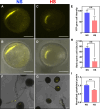Heat stress at the bicellular stage inhibits sperm cell development and transport into pollen tubes
- PMID: 38366643
- PMCID: PMC11213256
- DOI: 10.1093/plphys/kiae087
Heat stress at the bicellular stage inhibits sperm cell development and transport into pollen tubes
Abstract
For successful double fertilization in flowering plants (angiosperms), pollen tubes deliver 2 nonmotile sperm cells toward female gametes (egg and central cell, respectively). Heatwaves, especially during the reproduction period, threaten male gametophyte (pollen) development, resulting in severe yield losses. Using maize (Zea mays) as a crop and grass model system, we found strong seed set reduction when moderate heat stress was applied for 2 d during the uni- and bicellular stages of pollen development. We show that heat stress accelerates pollen development and impairs pollen germination capabilities when applied at the unicellular stage. Heat stress at the bicellular stage impairs sperm cell development and transport into pollen tubes. To understand the course of the latter defects, we used marker lines and analyzed the transcriptomes of isolated sperm cells. Heat stress affected the expression of genes associated with transcription, RNA processing and translation, DNA replication, and the cell cycle. This included the genes encoding centromeric histone 3 (CENH3) and α-tubulin. Most genes that were misregulated encode proteins involved in the transition from metaphase to anaphase during pollen mitosis II. Heat stress also activated spindle assembly check point and meta- to anaphase transition genes in sperm cells. In summary, misregulation of the identified genes during heat stress at the bicellular stage results in sperm cell development and transport defects ultimately leading to sterility.
© The Author(s) 2024. Published by Oxford University Press on behalf of American Society of Plant Biologists.
Conflict of interest statement
Conflict of interest statement. None declared.
Figures







Similar articles
-
Using maize as a model to study pollen tube growth and guidance, cross-incompatibility and sperm delivery in grasses.Ann Bot. 2011 Sep;108(4):727-37. doi: 10.1093/aob/mcr017. Epub 2011 Feb 23. Ann Bot. 2011. PMID: 21345919 Free PMC article. Review.
-
A new link between stress response and nucleolar function during pollen development in Arabidopsis mediated by AtREN1 protein.Plant Cell Environ. 2014 Mar;37(3):670-83. doi: 10.1111/pce.12186. Epub 2013 Oct 3. Plant Cell Environ. 2014. PMID: 23961845
-
Male Sterility in Maize after Transient Heat Stress during the Tetrad Stage of Pollen Development.Plant Physiol. 2019 Oct;181(2):683-700. doi: 10.1104/pp.19.00707. Epub 2019 Aug 4. Plant Physiol. 2019. PMID: 31378720 Free PMC article.
-
Genome-scale analysis and comparison of gene expression profiles in developing and germinated pollen in Oryza sativa.BMC Genomics. 2010 May 28;11:338. doi: 10.1186/1471-2164-11-338. BMC Genomics. 2010. PMID: 20507633 Free PMC article.
-
Speed dating, rejection, and finding the perfect mate: advice from flowering plants.Curr Opin Plant Biol. 2013 Oct;16(5):590-7. doi: 10.1016/j.pbi.2013.08.005. Epub 2013 Sep 7. Curr Opin Plant Biol. 2013. PMID: 24021868 Review.
Cited by
-
Maize stigmas react differently to self- and cross-pollination and fungal invasion.Plant Physiol. 2024 Dec 2;196(4):3071-3090. doi: 10.1093/plphys/kiae536. Plant Physiol. 2024. PMID: 39371027 Free PMC article.
-
Impact of High-Temperature Stress on Maize Seed Setting: Cellular and Molecular Insights of Thermotolerance.Int J Mol Sci. 2025 Feb 2;26(3):1283. doi: 10.3390/ijms26031283. Int J Mol Sci. 2025. PMID: 39941051 Free PMC article. Review.
-
Mechanisms underlining Kelp (Saccharina japonica) adaptation to relative high seawater temperature.BMC Genomics. 2025 Feb 24;26(1):186. doi: 10.1186/s12864-025-11382-7. BMC Genomics. 2025. PMID: 39994530 Free PMC article.
-
Evolution of NAC transcription factors from early land plants to domesticated crops.Plant Cell Physiol. 2025 May 17;66(4):566-580. doi: 10.1093/pcp/pcae133. Plant Cell Physiol. 2025. PMID: 39720999 Free PMC article.
-
Heat shock: Impact of moderate temperature on pollen development in maize.Plant Physiol. 2024 Jun 28;195(3):1765-1766. doi: 10.1093/plphys/kiae207. Plant Physiol. 2024. PMID: 38593024 Free PMC article. No abstract available.
References
-
- Ahmadli U, Kalidass M, Khaitova LC, Fuchs J, Cuacos M, Demidov D, Zuo S, Pecinkova J, Mascher M, Ingouff M, et al. . High temperature increases centromere-mediated genome elimination frequency and enhances haploid induction in Arabidopsis. Plant Commun. 2023:4(3):100507. 10.1016/j.xplc.2022.100507 - DOI - PMC - PubMed
MeSH terms
Substances
Grants and funding
LinkOut - more resources
Full Text Sources

